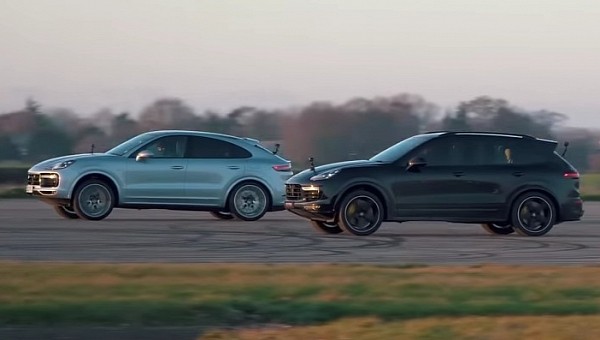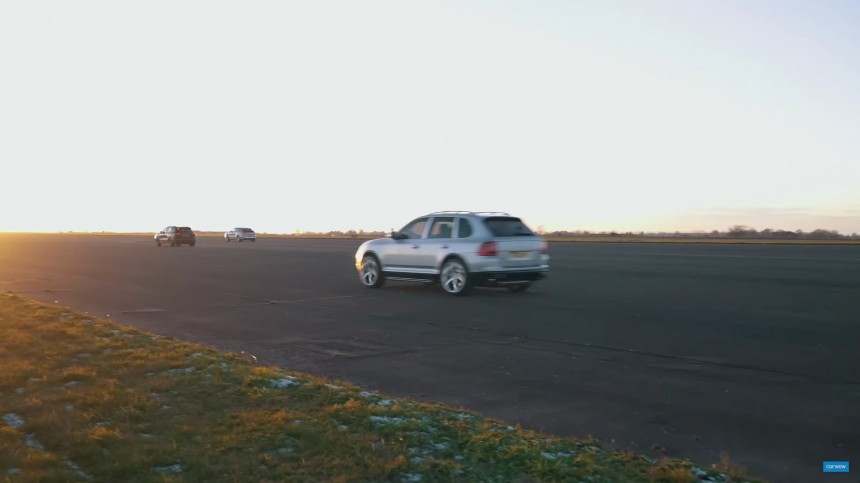Just how much better Porsches get over generations is a question a gearhead can answer in countless ways. Technology, engineering, materials, aerodynamics, computers, and the list could embrace a large portion of the internet if we keep adding to it.
To narrow it down, carwow’s YouTuber Mat Watson devised a crude but bluntly honest test. Regarding the core of the matter, there’s only one proper yardstick by which piston addicts measure performance: top speed.
Like perpetual four-year-olds, car enthusiasts have undeniable methods of demonstrating even the most complicated theories. All that science roots back to a straightforward equation: the 440-yard-long sprint.
However, Porsche built many models and versions of those models during its history. A YouTube video with all of them drag racing against one another would make a majestic sight (site?) if it were ever to become real.
Carwow’s ours truly gathered three specific Porsche cars from one historical model – the Cayenne. This car would save Porsche from the financial gallows at the turn of the millennia. In 2002, the company’s first-ever off-road SUV hit the streets – and we have America to thank for that.
Were it not for the feedback from the New World sales associations, Porsche would have scrapped the SUV idea. But since it came from the company’s largest market, they took it seriously and built the car.
Fast forward two decades, and all three generations of the Cayenne line up for a quarter-mile dash. Representing the primordial Porsche SUV, the oldest example on the track is the Turbo. V8-powered, all-wheel-driven, six-speed automatic, and two turbos - the whole nine yards that won wealthy buyers’ hearts (and wallets).
4.5 liters and 444 bhp (450 ps), and 457 lb-ft (620 Nm) were impressive numbers in 2002. But, at 2.3 tons, it’s not exactly lightweight. One decade later, the second generation cracked its shell and left its marks on the automotive world. This time, the Turbo S package came with a slightly larger displacement – 4.8 liters, twin-turbo forced feeding, also AWD.
But a decade is to Porsche what an ice age is to paleontology – a period of colossal magnitude changes. Therefore, the second Cayenne comes with 562 bhp (570 ps) and 590 lb-ft (800 Nm). Just as if it hit the gym heavily, it also shed some weight – so all that power has to carry around 2.2 tons.
As the third decade of this millennium was closing in, Porsche embarked on the electric (drive)train. Naturally, its flagship received the hybrid spoils for the third iteration of the model. The Cayenne Turbo S E-Hybrid has a smaller engine – 4.0 liters, but still, eight pistons, correctly arranged under the V sign.
It also has an electric motor, which takes the total power yield to 671 bhp (680 ps) and a hefty 664 lb-ft (900 Nm) of spin force. That immediately translates into two feats: a very quick-of-the-line pace and a significant weight gain (battery pack drawback) – 2.5 tons.
So, with all that in perspective, it’s time to find the answer to the unsettling question: how much better is a new Porsche over its oldest sibling? Well, as the video proves, a lot better. And I’m not talking about the electric-gasoline cheater that shoots off and stays in front effortlessly. The second-gen Cayenne impolitely turns its back on the old model and beats it badly.
Sure, more power and less weight are two decisive factors. The standing quarter mile times are razor-blade ruthless: 11.6 seconds vs. 12 seconds vs. 13.7 seconds, going from newest to oldest Cayenne.
The pattern repeats identically in the roll race – older cars are inferior in performance to newer ones. That’s not to say they’re not good or altogether wrong, but they lack the punching power to stack up against the young versions of themselves.
In other words, old cars are still heaps of fun – perhaps this is one aspect in which new automobiles will never be able to best their seniors.
Like perpetual four-year-olds, car enthusiasts have undeniable methods of demonstrating even the most complicated theories. All that science roots back to a straightforward equation: the 440-yard-long sprint.
However, Porsche built many models and versions of those models during its history. A YouTube video with all of them drag racing against one another would make a majestic sight (site?) if it were ever to become real.
Carwow’s ours truly gathered three specific Porsche cars from one historical model – the Cayenne. This car would save Porsche from the financial gallows at the turn of the millennia. In 2002, the company’s first-ever off-road SUV hit the streets – and we have America to thank for that.
Were it not for the feedback from the New World sales associations, Porsche would have scrapped the SUV idea. But since it came from the company’s largest market, they took it seriously and built the car.
Fast forward two decades, and all three generations of the Cayenne line up for a quarter-mile dash. Representing the primordial Porsche SUV, the oldest example on the track is the Turbo. V8-powered, all-wheel-driven, six-speed automatic, and two turbos - the whole nine yards that won wealthy buyers’ hearts (and wallets).
But a decade is to Porsche what an ice age is to paleontology – a period of colossal magnitude changes. Therefore, the second Cayenne comes with 562 bhp (570 ps) and 590 lb-ft (800 Nm). Just as if it hit the gym heavily, it also shed some weight – so all that power has to carry around 2.2 tons.
As the third decade of this millennium was closing in, Porsche embarked on the electric (drive)train. Naturally, its flagship received the hybrid spoils for the third iteration of the model. The Cayenne Turbo S E-Hybrid has a smaller engine – 4.0 liters, but still, eight pistons, correctly arranged under the V sign.
It also has an electric motor, which takes the total power yield to 671 bhp (680 ps) and a hefty 664 lb-ft (900 Nm) of spin force. That immediately translates into two feats: a very quick-of-the-line pace and a significant weight gain (battery pack drawback) – 2.5 tons.
Sure, more power and less weight are two decisive factors. The standing quarter mile times are razor-blade ruthless: 11.6 seconds vs. 12 seconds vs. 13.7 seconds, going from newest to oldest Cayenne.
The pattern repeats identically in the roll race – older cars are inferior in performance to newer ones. That’s not to say they’re not good or altogether wrong, but they lack the punching power to stack up against the young versions of themselves.
In other words, old cars are still heaps of fun – perhaps this is one aspect in which new automobiles will never be able to best their seniors.





























